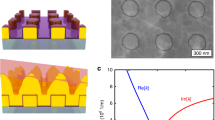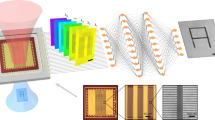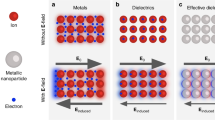Abstract
Resonantly enhanced light transmission through periodic subwavelength aperture arrays perforated in metallic films1 has generated significant interest because of potential applications in near-field microscopy, photolithography, displays, and thermal emission2. The enhanced transmission was originally explained by a mechanism where surface plasmon polaritons (collective electronic excitations in the metal surface) mediate light transmission through the grating1,3. In this picture, structural periodicity is perceived to be crucial in forming the transmission resonances. Here we demonstrate experimentally that, in contrast to the conventional view, sharp transmission resonances can be obtained from aperiodic aperture arrays. Terahertz transmission resonances are observed from several arrays in metallic films that exhibit unusual local n-fold rotational symmetries, where n = 10, 12, 18, 40 and 120. This is accomplished by using quasicrystals with long-range order, as well as a new type of ‘quasicrystal approximates’ in which the long-range order is somewhat relaxed. We find that strong transmission resonances also form in these aperiodic structures, at frequencies that closely match the discrete Fourier transform vectors in the aperture array structure factor. The shape of these resonances arises from Fano interference4 of the discrete resonances and the non-resonant transmission band continuum related to the individual holes5. Our approach expands potential design parameters for aperture arrays that are aperiodic but contain discrete Fourier transform vectors, and opens new avenues for optoelectronic devices.
This is a preview of subscription content, access via your institution
Access options
Subscribe to this journal
Receive 51 print issues and online access
$199.00 per year
only $3.90 per issue
Buy this article
- Purchase on Springer Link
- Instant access to full article PDF
Prices may be subject to local taxes which are calculated during checkout



Similar content being viewed by others
References
Ebbesen, T. W., Lezec, H. J., Ghaemi, H. F., Thio, T. & Wolff, P. A. Extraordinary optical transmission through sub-wavelength hole arrays. Nature 391, 667–669 (1998)
Barnes, W. L., Dereux, A. & Ebbesen, T. W. Surface plasmon subwavelength optics. Nature 424, 824–830 (2003)
Ghaemi, H. F., Thio, T., Grupp, D. E., Ebbesen, T. W. & Lezec, H. J. Surface plasmons enhance optical transmission through subwavelength holes. Phys. Rev. B 58, 6779–6782 (1998)
Genet, C., van Exter, M. P. & Woerdman, J. P. Fano-type interpretation of red shifts and red tails in hole array transmission spectra. Opt. Commun. 225, 331–336 (2003)
Garcia de Abajo, F. J., Saenz, J. J., Campillo, I. & Dolado, J. S. Site and lattice resonances in metallic hole arrays. Opt. Express 14, 7–18 (2006)
Janot, C. Quasicrystals: A Primer 2nd edn (Oxford Univ. Press, New York, 1994)
Cao, H. & Nahata, A. Influence of aperture shape on transmission properties of a periodic array of subwavelength apertures. Opt. Express 12, 3664–3672 (2004)
Kaliteevski, M. A. et al. Diffraction and transmission of light in low-refractive index Penrose-tiled photonic quasicrystals. J. Phys. Condens. Matter 13, 10459–10470 (2001)
Oxborrow, M. & Henley, L. C. Random square-triangle tilings: A model for twelve fold-symmetric quasicrystals. Phys. Rev. B 48, 6966–6998 (1993)
Bethe, H. A. Theory of diffraction by small holes. Phys. Rev. 66, 163–182 (1944)
Agrawal, A. & Nahata, A. Time-domain radiative properties of a single subwavelength aperture surrounded by an exit side surface corrugation. Opt. Express 14, 1973–1981 (2006)
Penrose, R. The role of aesthetics in pure and applied mathematical research. Bull. Inst. Math. Appl. 10, 266–271 (1974)
Zoorob, M. E., Charlton, M. D. B., Parker, G. J., Baumberg, J. J. & Netti, M. C. Complete photonic bandgaps in 12-fold symmetric quasicrystals. Nature 404, 740–743 (2000)
Sun, M. et al. The role of periodicity in enhanced transmission through subwavelength hole arrays. Chin. Phys. Lett. 23, 486–488 (2006)
Przybilla, F., Genet, C. & Ebbesen, T. W. Enhanced transmission through Penrose subwavelength hole arrays. Appl. Phys. Lett. 89, 121115 (2006)
Koerkamp, K. J. K., Enoch, S., Segerink, F. B., van Hulst, N. F. & Kuipers, L. Strong influence of hole shape on extraordinary transmission through periodic arrays of subwavelength holes. Phys. Rev. Lett. 92, 183901 (2004)
Fano, U. Effects of configuration interaction on intensities and phase shifts. Phys. Rev. 124, 1866–1873 (1961)
Österbacka, R., Jiang, X. M., An, C. P., Horovitz, B. & Vardeny, Z. V. Photoinduced quantum interference antiresonances in π-conjugated polymers. Phys. Rev. Lett. 88, 226401 (2002)
Sarrazin, M., Vigneron, J. P. & Vigoureux, J. M. Role of Wood anomalies in optical properties of thin metallic films with bidimensional array of subwavelength holes. Phys. Rev. B 67, 085415 (2003)
Lee, T. D. M., Parker, G. J., Zoorob, M. E., Cox, S. J. & Charlton, M. D. B. Design and simulation of highly symmetric photonic quasi-crystals. Nanotechnology 16, 2703–2706 (2005)
Matsui, T., Agrawal, A., Nahata, A. & Vardeny, Z. V. Enhanced transmission properties of aperiodic aperture arrays in metallic and semiconductor films and their application to optoelectronic devices. University of Utah Patent Disclosure (2006)
Acknowledgements
This work was supported in part by the Army Research Office and the SYNERGY programme at the University of Utah.
Author information
Authors and Affiliations
Corresponding authors
Ethics declarations
Competing interests
Reprints and permissions information is available at www.nature.com/reprints. The authors declare no competing financial interests.
Supplementary information
Supplementary Information
This file contains Supplementary Methods, Supplementary Figures 1-3 with Legends, Supplementary Tables 1-2 and additional references. (PDF 559 kb)
Rights and permissions
About this article
Cite this article
Matsui, T., Agrawal, A., Nahata, A. et al. Transmission resonances through aperiodic arrays of subwavelength apertures. Nature 446, 517–521 (2007). https://doi.org/10.1038/nature05620
Received:
Accepted:
Issue Date:
DOI: https://doi.org/10.1038/nature05620
This article is cited by
-
Ultrafast visualization of an electric field under the Lorentz transformation
Nature Physics (2022)
-
Optical Fourier surfaces
Nature (2020)
-
High Throughput Laser Process of Transparent Conducting Surfaces for Terahertz Bandpass Ultrathin Metamaterials
Scientific Reports (2019)
-
Near-field imaging of surface-plasmon vortex-modes around a single elliptical nanohole in a gold film
Scientific Reports (2019)
-
Plasmonic Lens Based on Rectangular Holes
Plasmonics (2018)
Comments
By submitting a comment you agree to abide by our Terms and Community Guidelines. If you find something abusive or that does not comply with our terms or guidelines please flag it as inappropriate.



